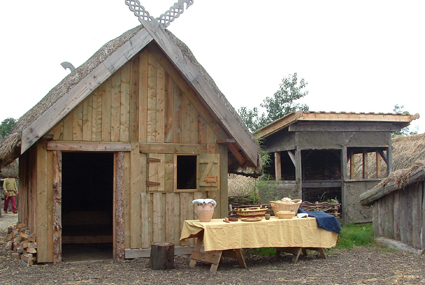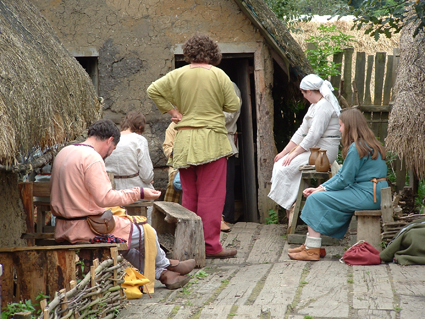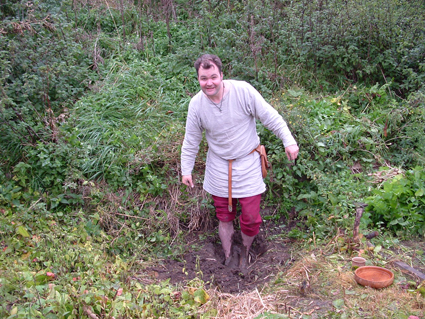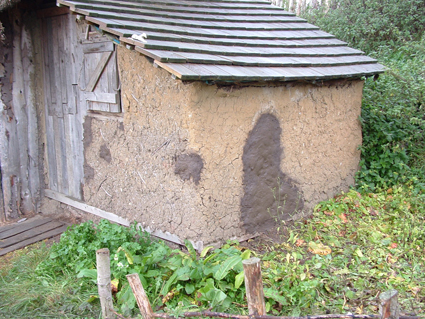At which the Vikings and Englisc both prepared for the battle to seal the fate of Mercia, and an introspective Viking leader, Ivar the Boneless, asked the assembled forces exactly what they wanted.
The war season, 874. The Viking Great Army gathered at Repton in Mercia, home to the burial crypt of the Mercian kings. Meanwhile King Burhred of Mercia, having listened to Alfred’s advice, assembled his forces, called the fyrd, prepared for a counter-attack to seal his fate and the fate of his kingdom. And Ceolwulf, claiming to be the rightful king of Mercia, descendant of the King Ceolwulf who fled Mercia 50 years ago, said that if he were King he would bring peace with the Vikings by paying them to leave.
In a hall near Repton some of the Vikings gathered to prepare for the coming battle – working on their equipment in the forge, fletching arrows, repairing their tunics for possibly the last time. They were visited by envoys and friends from among the Mercians. At the start of the feast, Hersir Hauk of the Oestvikingae spoke. He said that with King Burhred of Mercia gathering his forces, there would soon be war – but for now there was peace, and we should dine well as it may be one of our last meals.
As the guests were tucking into their rich beef stew, the hall was visited by an exceptionally tall and gaunt figure: Ivar ‘the Boneless’ Ragnarsson, eldest of the sons of Ragnar, pre-eminent leader of the Great Army. He was unstable on his feet, leaning on his daneaxe and the hall’s pillars to stand. He said that he was ill, and old. He had been harrying the Englisc for 10 years, ever since his father Ragnar Loðbrók had been killed in Jorvic, leading the Great Army to seek revenge and wealth. He had killed his father’s killer, brought the Northumbrian kingdom centered on Jorvic to its knees, and also crushed the East Anglians. But now, seeing his death approaching, he wanted to make sure that he had done right according to his followers, so asked them what they wanted.
Ingibjorg of the Holmbyggjar spoke of her desire to find a land to live in. She had come to the Englisc lands in the Great Summer Army led by Guthrum, 3 years ago, seeking a quick victory of Wessex and Mercia in order to win herself a place to live. She saw the need to crush Mercia, to take and secure her land with blood, to fulfill the curse placed by the volvas on King Burhred, but ultimately wanted to settle – ideally in East Anglia, with trade-routes to Denmark.
She asked too for clarity on the succession – who would lead the Vikings if Ivar died? Ivar said that the strongest leader would rule, and whoever he nominated did not matter.
Wulf of the Westmen said that he was a mercenary, and spoke of his desire for money. He saw the best route as a bloody path, conquering the Englisc lands and forcing the Englisc to pay rent. However he agreed with Ingibjorg: the land must be won with blood.
Hallgerd of the Westmen agreed – like Wulf, she simply wanted money, won with blood. She has land on the isle of Canna off the land of the Scots, and has no interest in settling on the mainland or who rules here.
Young Cnut of the Oestvikingae, cousin of Hauk, also wanted money – and wanted to grow up a warrior, earning his money with a sword; not a farmer, living in peace.
Wulfruna of the Cilternsaete said that she, possibly unlike her lord Herewulf, ultimately desired peace. But a peace of equals, not the peace of the servant.
Wulfgar of the Cilternsaete, her son, was more direct and violent. He saw that only blood, and the sword, would decide the matter – and threatened to stab King Ivar himself!
Ivar coughed, a terrible fit. He acknowledged that since all wished it so and none could see a peaceful route, there could be no peace without war first, and that the blood must flow. He then withdrew, to visit the other halls where his followers gathered, and talk to them too before battle came. Because it was now certain that battle would come, and the fate of Mercia would be decided with blood…
Ingibjorg’s lament
Ivar Ragnarsson (‘the Boneless’) asked the Viking war-leaders for their counsel – should they treat with the Englisc or fight? In reply, had she thought of them at the time, Ingibjorg Ragnarsdottir (no relation) would certainly have spoken these lines.I do not crave the blood-speech of the battle tongues;
I would weave weapons’ woe.
I rode across Njord’s pasture,
My steed thundering over the world worm’s burrow,
In search of green pastures of my own.My parents live in the hall of the daughter
Of the thunder-god’s companion.
My husband and my son are Freyja’s guests.
Our lands feed the milk-givers of our foes
And I have no weaving-frame to offer
To my dear daughter Dagrun.The father-god of the shield trees
Vowed that those trees and their saplings
Would thrust their roots into the west-land valleys.How then shall I cry craven?
No sword-swinger I – barely can I thrust a spear,
Yet if any home I have, it lies here.
Historical Note – Ivar ‘the Boneless’
Ivar the Boneless is, like many of the Viking leaders, a shadowy figure, straddling legend and history. It is possible that he might be the same figure as the King Ímar of Irish sources, founder of the Uí Ímair dynasty who ruled Dublin, parts of Scotland, and the Hebrides. It is recorded that Ímar died in 873 in Britain. Some accounts don’t say how he die, others say that it is due to an illness. In the Saga of Ragnar’s Sons, he is reported to die childless, of old age – although the Irish King Ímar, in contrast, had several children when he founded his dynasty.
It is not known what Ivar’s ‘the Boneless’ nickname refers to. Some have suggested that it might be a muscular condition meaning he couldn’t use his limbs (although that is contradicted by saga descriptions of him as tall and powerful); others that it could refer to erectile issues (hence the childlessness).
One possible solution to the riddle was uncovered by a farm labourer, Thomas Walker, in Repton in 1686. He dug up a burial mound, uncovering a stone coffin containing ‘a Skeleton of a Humane Body Nine Foot long’, buried with over 100 skeletons arrayed around him. This was clearly an important person, buried with great ritual. Could the (now lost) skeletal giant be that of Ivar ‘the Boneless’, the nick-name an ironic one much like ‘Little’ John? If so, this would tally with the Irish sources giving 873 as his year of death (as it was in 873 & 874 that the Vikings were in Repton). So that’s the theory we’ve gone with!












